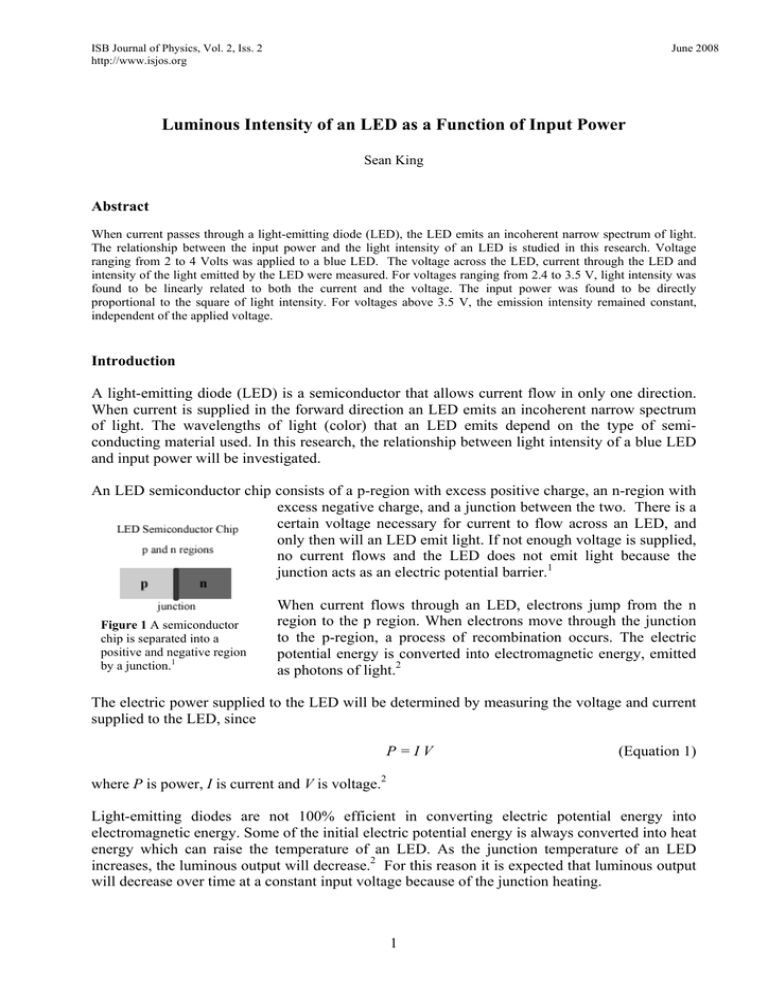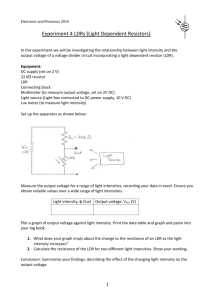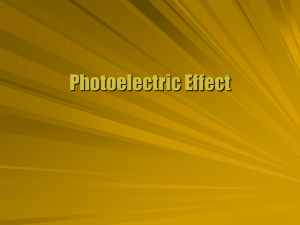Luminous Intensity of an LED as a Function of Input Power
advertisement

ISB Journal of Physics, Vol. 2, Iss. 2 http://www.isjos.org June 2008 Luminous Intensity of an LED as a Function of Input Power Sean King Abstract When current passes through a light-emitting diode (LED), the LED emits an incoherent narrow spectrum of light. The relationship between the input power and the light intensity of an LED is studied in this research. Voltage ranging from 2 to 4 Volts was applied to a blue LED. The voltage across the LED, current through the LED and intensity of the light emitted by the LED were measured. For voltages ranging from 2.4 to 3.5 V, light intensity was found to be linearly related to both the current and the voltage. The input power was found to be directly proportional to the square of light intensity. For voltages above 3.5 V, the emission intensity remained constant, independent of the applied voltage. Introduction A light-emitting diode (LED) is a semiconductor that allows current flow in only one direction. When current is supplied in the forward direction an LED emits an incoherent narrow spectrum of light. The wavelengths of light (color) that an LED emits depend on the type of semiconducting material used. In this research, the relationship between light intensity of a blue LED and input power will be investigated. An LED semiconductor chip consists of a p-region with excess positive charge, an n-region with excess negative charge, and a junction between the two. There is a certain voltage necessary for current to flow across an LED, and only then will an LED emit light. If not enough voltage is supplied, no current flows and the LED does not emit light because the junction acts as an electric potential barrier.1 Figure 1 A semiconductor chip is separated into a positive and negative region by a junction.1 When current flows through an LED, electrons jump from the n region to the p region. When electrons move through the junction to the p-region, a process of recombination occurs. The electric potential energy is converted into electromagnetic energy, emitted as photons of light.2 The electric power supplied to the LED will be determined by measuring the voltage and current supplied to the LED, since P=IV (Equation 1) where P is power, I is current and V is voltage.2 Light-emitting diodes are not 100% efficient in converting electric potential energy into electromagnetic energy. Some of the initial electric potential energy is always converted into heat energy which can raise the temperature of an LED. As the junction temperature of an LED increases, the luminous output will decrease.2 For this reason it is expected that luminous output will decrease over time at a constant input voltage because of the junction heating. 1 ISB Journal of Physics June 2008 Methods A circuit with a voltage divider was constructed to enable a variable voltage to be applied to the LED. An ammeter and a voltmeter were connected as shown in figure 2. Once the LED circuit was set up, the light intensity meter was clamped facing the LED as shown in figure 3. The positioning of the light intensity meter in relation to the LED was kept constant and the room was darkened to reduce uncertainties in light meter readings. It was noted that the light intensity of the LED dropped significantly when left on over a period of 100 seconds. To control this variable, the light intensity was measured when the LED was first turned on, and the LED was turned off for at least 30 seconds between measurements. The initial voltage and current readings were noted and the average light intensity reading for the first second was measured. The input power was calculated using equation 1. Figure 2 Diagram of the circuit used. Four AA batteries were used. This process was repeated three times for six different currents and voltages. Results and Discussion The voltage applied to the LED and the emitted light intensity are linearly related up to a voltage of 3.5 V. The x intercept of the linear fit is 2.69 +/0.02 V. This is the voltage at which the LED starts to give off light. Relationship Between Voltage and Light Intensity At 2.6 V, the data point lies above the linear fit. This suggests that the LED may be more efficient just above the ignition ) voltage, although more measurements Figure 3 Light intensity as a function of voltage. A linear relationship is shown up to need to be made to 3.5 V. confirm this observation. 2 ISB Journal of Physics Above 3.5 V, the light intensity seems to have reached a maximum level. Increasing the voltage above this saturation point has no affect on the light intensity. Figure 4 shows that the current through the blue LED and the light intensity are directly proportional for currents of less than 20 mA. For larger currents the light intensity remains constant. Figure 5 shows that at high input power, light intensity reaches a maximum as the LED reaches saturation. Only for input power between approximately zero and 0.08 W is the input power linearly related to the square of light intensity. June 2008 Relationship Between Current and Light Intensity x 103 lux/mA ) Figure 4 Light intensity as a function of current. A proportional relationship is shown up to 20 mA, corresponding to 3.5 V. Relationship Between Power and Light Intensity y = mx + b m (Slope): 440 x 10 6 lux 2 / W (+/-0.002) b (Y-intercept) : -2.2 x 10 6 lux 2 Conclusion and Evaluation The voltage across, and the current through the blue LED were both linearly ) related to light emission intensity, Figure 5 The square of Light intensity as a function of power input to the LED. A while input power linear relationship is shown up to 0.06 W. was linearly related to the square of the light intensity. At high values of voltage, (and consequently, high currents and power inputs), the linear relationships no longer held. The light intensity of the LED reached a maximum as the LED become saturated. 3 ISB Journal of Physics June 2008 During test trials, it was found that the intensity of the LED light output decreased significantly over a period of 100 seconds. An interval of 30 seconds between each data collection was used. Five or ten minute intervals may yield higher light intensities, as the LED might more fully recover. The first data point of Figure 3 lies above the linear fit, indicating deviation from the linear relationship for low voltages. In future work the region close to the threshold voltage with very low currents and output light intensities could be investigated to determine whether the linear relationships hold for very low photon outputs. As current passes through an LED, the junction temperature rises. Higher temperatures result in lower light intensities.3 Another area for future work is to investigate how the LED temperature increases over a period of time with a constant current. Finally, the spectrum of the light emitted by a particular LED at different voltages could be investigated. References 1 Wyckoff, S. (1999, February 22). What is Inside an LED? In Experiments by Exploration. Retrieved May 25, 2008, from Department of Physics & Astronomy, Arizona State University Web site: http://acept.asu.edu/courses/phs110/expmts/exp13a.html 2 Hecht, E. (2003). Physics Algebra/Trig (3rd ed.). Canada: Thomson Learning Inc. 3 Fischer, A. (2007, June) Measuring LED Junction Temperature. In Photonics Spectra. Retrieved June 11, 2008, from Photonics.com Web site: http://www.photonics.com/content/ spectra/2007/June/LED/87888.aspx 4 Cooper, J. (2007, August 21). LED lamps - some simple design guidelines. Retrieved June 11, 2008, from Marl Technical Library Web site: http://www.leds.co.uk/library/techbul/85 4




